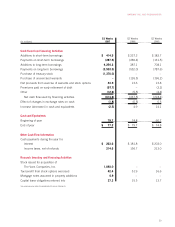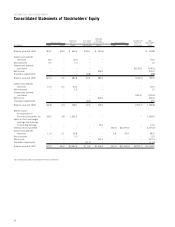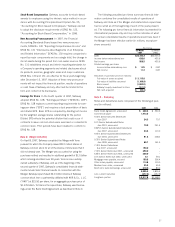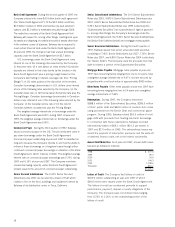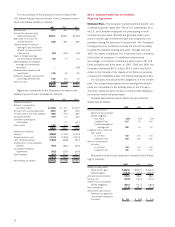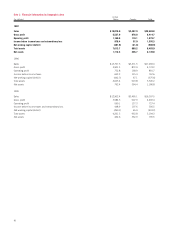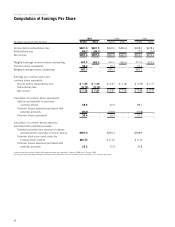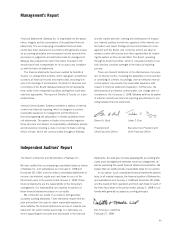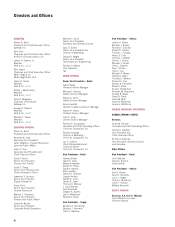Safeway 1997 Annual Report Download - page 36
Download and view the complete annual report
Please find page 36 of the 1997 Safeway annual report below. You can navigate through the pages in the report by either clicking on the pages listed below, or by using the keyword search tool below to find specific information within the annual report.
33
The funded status of the Plans at year-end was as follows
(in millions):
1997 1996
Fair value of assets at year-end $1,662.6 $1,392.0
■■
Actuarially determined present value of:
Vested benefit obligations 916.7 758.9
Non-vested benefit obligations 15.8 9.3
■■
Accumulated benefit obligations 932.5 768.2
Additional amounts related to
projected compensation
increases 124.3 98.9
■■
Projected benefit obligations 1,056.8 867.1
■■
Fair value of assets in excess of
projected benefit obligations 605.8 524.9
Adjustment for difference in book
and tax basis of assets (165.1) (165.1)
Unamortized prior service costs
resulting from improved Plan
benefits 93.7 83.3
Net gain from actuarial experience
which has not been recognized in
the consolidated financial
statements (193.0) (114.4)
■■
Prepaid pension costs $ 341.4 $ 328.7
■■
Retirement Restoration Plan The Retirement Restoration Plan
provides death benefits and supplemental income payments for
senior executives after retirement. The Company recognized
expense of $4.3 million in 1997, $4.4 million in 1996 and $3.4
million in 1995. The aggregate projected benefit obligation of the
Retirement Restoration Plan was approximately $48.4 million at
year-end 1997 and $44.9 million at year-end 1996.
Postretirement Benefits Other Than Pensions In addition to pen-
sion and the Retirement Restoration Plan benefits, the Company
sponsors plans that provide postretirement medical and life
insurance benefits to certain salaried employees. Retirees share
a portion of the cost of the postretirement medical plans.
Safeway pays all of the cost of the life insurance plans. The
plans are not funded.
In 1996, the Safeway postretirement medical plan was
amended to restrict the types of coverage available, to change
the participant contributions, and to exclude future retirees from
participating in the plan. The exclusion of future retirees in the
plan was considered a curtailment under the provisions of SFAS
No. 88 which resulted in recognition of a curtailment gain of
$14.5 million in 1996. In 1997, similar amendments were made
to the Vons postretirement medical plan, resulting in a $14.0
million adjustment to the accumulated postretirement benefit
obligation (“APBO”) at the date of the Merger.
The Company’s APBO was $28.4 million at year-end 1997
and $15.9 million at year-end 1996. The APBO represents the
actuarial present value of benefits expected to be paid after
retirement. Postretirement benefit expense was $2.2 million in
1997, $1.7 million in 1996 and $2.5 million in 1995.
The significant assumptions used to determine the periodic
postretirement benefit expense and the APBO were as follows:
1997 1996 1995
Discount rate 7.0% 7.0% 7.0%
Rate of compensation increase 5.5 5.5 5.5
For 1998, a 7.5% annual rate of increase in the per capita
cost of postretirement medical benefits provided under the
Company’s group health plan was assumed. The rate was
assumed to decrease gradually to 5.5% for 2002 and remain at
that level thereafter. A 5.5% annual rate of increase was
assumed for 1998 and thereafter in the per capita cost of postre-
tirement benefits provided under HMO plans. If the health care
cost trend rate assumptions were increased by 1% in each year,
the APBO as of year-end 1997 would increase $0.8 million, and
the net periodic postretirement benefit expense for 1997 would
remain unchanged. Retiree contributions have historically been
adjusted when plan costs increase. The APBO for the medical
plans anticipates future cost-sharing changes to the written plan
that are consistent with the Company’s past practice.
Multi-Employer Pension Plans Safeway participates in various
multi-employer pension plans, covering virtually all Company
employees not covered under the Company’s non-contributory
pension plans, pursuant to agreements between the Company
and employee bargaining units which are members of such plans.
These plans are generally defined benefit plans; however, in many
cases, specific benefit levels are not negotiated with or known by
the employer-contributors. Contributions of $130 million in 1997,
$112 million in 1996 and $105 million in 1995 were made and
charged to income.
Under U.S. legislation regarding such pension plans, a
company is required to continue funding its proportionate
share of a plan’s unfunded vested benefits in the event of
withdrawal (as defined by the legislation) from a plan or plan
termination. Safeway participates in a number of these pen-
sion plans, and the potential obligation as a participant in
these plans may be significant. The information required to
determine the total amount of this contingent obligation, as
well as the total amount of accumulated benefits and net
assets of such plans, is not readily available. During 1988 and
1987, the Company sold certain operations. In most cases the
party acquiring the operation agreed to continue making con-
tributions to the plans. Safeway is relieved of the obligations
related to these sold operations to the extent the acquiring
parties continue to make contributions. Whether such sales
could result in withdrawal under ERISA and, if so, whether
such withdrawals could result in liability to the Company, is
not determinable at this time.


